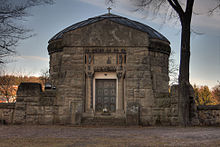Karl Robert Bruno Naumann at Königsbrück
Charles Robert Bruno Naumann later, after acquisition of the castle and Standesherrschaft Koenigsbrueck also Karl Robert Bruno Naumann Koenigsbrueck called (* 10. October 1844 in Dresden , † 22 January 1903 in Loschwitz ) was a German entrepreneur and the founder of the company Seidel & Naumann . He made contributions to the development of the sewing machine and in particular the typewriter . For this he was awarded the title of secret councilor by King Albert of Saxony .
Life
Naumann came to Dresden as the son of Moritz Ferdinand Naumann (1803–1882) and his first wife Juliane Christiane Naumann nee. House stone to the world. The father described himself as a stocking manufacturer and lived in adequate circumstances. However, he left the family shortly before the birth of his son Bruno and emigrated to the USA . Although he returned to Saxony after having become wealthy for a few years, his wife nevertheless divorced. The son Bruno proved to be mathematically gifted at school. After leaving school, he learned precision mechanics and watchmaking from various masters . Later, in addition to his work as a mechanic, he trained in evening classes in order to be able to read the original Greek literature. During his traveling years he worked in Berlin, Frankfurt am Main and Vienna.
After his return to Dresden, Bruno Naumann founded a small workshop for precision mechanics on August 5, 1868 with his own savings of some 100 thalers . In 1869, the merchant Emil Seidel invested 25,000 thalers in Naumann's company, which had been trading under the name Seidel & Naumann since 1870 . Although Seidel left the company in 1876 with a severance payment of 250,000 marks , the established company name remained. Bruno Naumann created a number of social institutions for his employees: a company health insurance fund for workers who have been with the company for many years and their relatives, benefit funds for longer illnesses and deaths, an invalidity fund and a civil servants benefit fund. In the workshops there was a generous amount of basic equipment with cloakrooms, toilets, washrooms and dining rooms. In Dresden he became a member of the Masonic lodge Zum golden Apfel .
In 1873 Bruno Naumann married the pharmacist's daughter Hermine Louise Hoffmann (1854–1880). A son emerged from the only seven-year marriage.
The Seidel & Naumann company was so economically successful that Naumann was able to acquire the Villa Stockhausen in Dresden in 1891 and the royal estate of Königsbrück in 1893 . On the one hand this was a capital investment, on the other hand it meant the better possibility of intensive care of his also very successfully pursued hobbies, hunting and horse breeding. However, unlike his son, he never lived in his castle in Königsbrück.
Naumann died in Loschwitz in 1903 in the Villa Albrechtsberg. He was first buried in the Johannisfriedhof in Dresden, but later transferred to the family's mausoleum in Königsbrück.
Heir and descendants
Bruno Naumann's only son, Dr. phil. Robert Bruno Walther Naumann zu Königsbrück (* May 2, 1874; † February 22, 1944), sold the Dresden Villa Stockhausen in 1906 to Karl August Lingner , who made it the Lingnerschloss . In 1907, the Königsbrücker Heide forest district, which was part of the domain, was sold to the German Reich, which set up a large military training area there.
Walther Naumann was the last nobleman at Königsbrück; In 1908 he also acquired the Tauscha manor . The right and the obligation to represent property in the First Chamber of the Estates Assembly was abolished in the Saxon Constitution of 1920. The Naumann family lived in the now renovated parts of the Königsbrück castle from 1917 to 1945. His grandson, the zoologist Clas Michael Naumann zu Königsbrück , spent his childhood in Königsbrück.
The company Seidel & Naumann was continued by the successors and was one of the most important large companies in Dresden until the severe damage in air raids in 1944/1945 and the expropriation after the war. The folding portable typewriter Erika Number 1, which was first produced in 1910 and named after Naumann's only granddaughter, became world famous.
literature
- Hans Christoph Graf von Seherr-Thoss: Naumann, Bruno. In: New German Biography (NDB). Volume 18, Duncker & Humblot, Berlin 1997, ISBN 3-428-00199-0 , p. 766 f. ( Digitized version ).
Web links
- History of the predecessor companies of the Robotron Combine
- Owner of Königsbrück
- Biography
- Entry in www.rechnerlexikon.de (patents, XxX with illustration)
Individual evidence
- ↑ Todtenschau . In: Dresdner Geschichtsblätter , No. 2, 1903, p. 176.
| personal data | |
|---|---|
| SURNAME | Naumann zu Königsbrück, Karl Robert Bruno |
| ALTERNATIVE NAMES | Naumann to Koenigsbrück, Bruno |
| BRIEF DESCRIPTION | Saxon entrepreneur and inventor |
| DATE OF BIRTH | October 10, 1844 |
| PLACE OF BIRTH | Dresden |
| DATE OF DEATH | January 22, 1903 |
| Place of death | Loschwitz |


